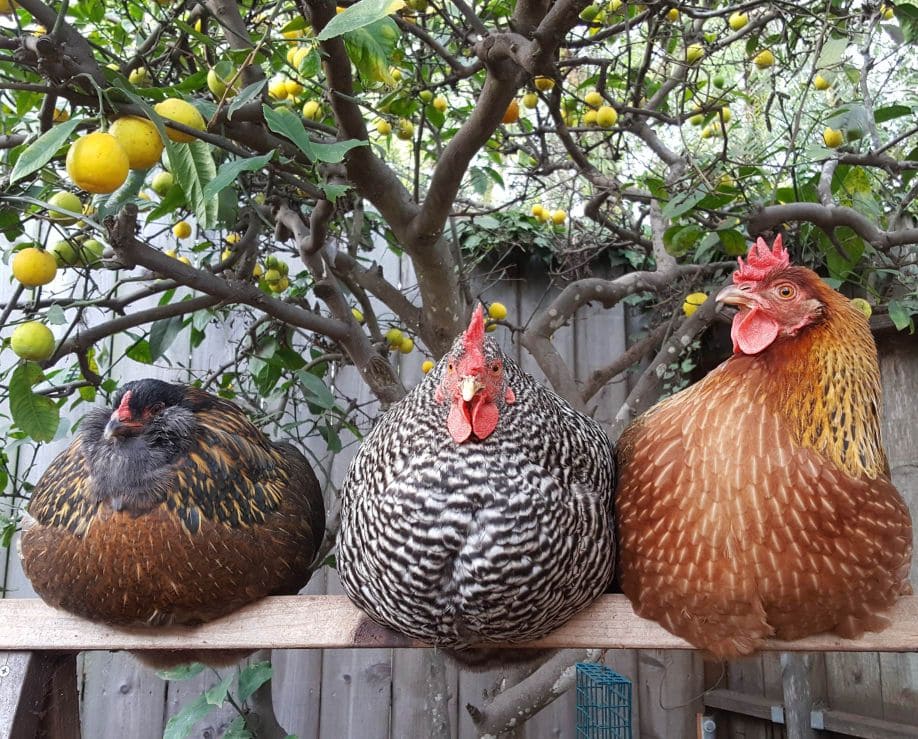
Backyard Chickens 101: What to Expect When You’re Expecting
So you’re considering adding to the family, are you? Here is your ultimate guide to help inform and prepare you to responsibly raise chickens! A backyard chickens 101 crash course of sorts.
The freshest, most nutritious and delicious eggs you can get. Adorable feathered friends happily cruising around your yard, and if you’re a lucky chosen one, hopping up in your lap for a sweet little afternoon cuddle sesh. Maybe while you sip on some wine or tea. A living food waste disposal system, and a provider of free rich manure. A new BFF for your toddler.
It all sounds so idyllic, am I right?
Well I hate to break it to you (and while much of the above is true) it is not all sunshine and golden egg yolks when it comes to backyard chickens. Is it hard to take care of them? No! Not at all. Chickens are friendly, inquisitive, entertaining, and fairly low-maintenance animals. Yet like any other pet, there is certainly some preparation and ongoing upkeep that comes along with keeping backyard chickens. In our eyes, they’re like any other pet and deserve the same care and love.
The intent of this article is not to dissuade you from getting them, by any means. We adore our girls and wouldn’t give them up for anything, despite the shenanigans they put us through sometimes! I simply want you to be prepared to make informed decisions, for everyones sake involved. This article will cover everything from where to get backyard chickens, how to provide them a safe and happy habitat, free ranging considerations, predator-proofing, daily care, food, water and more!
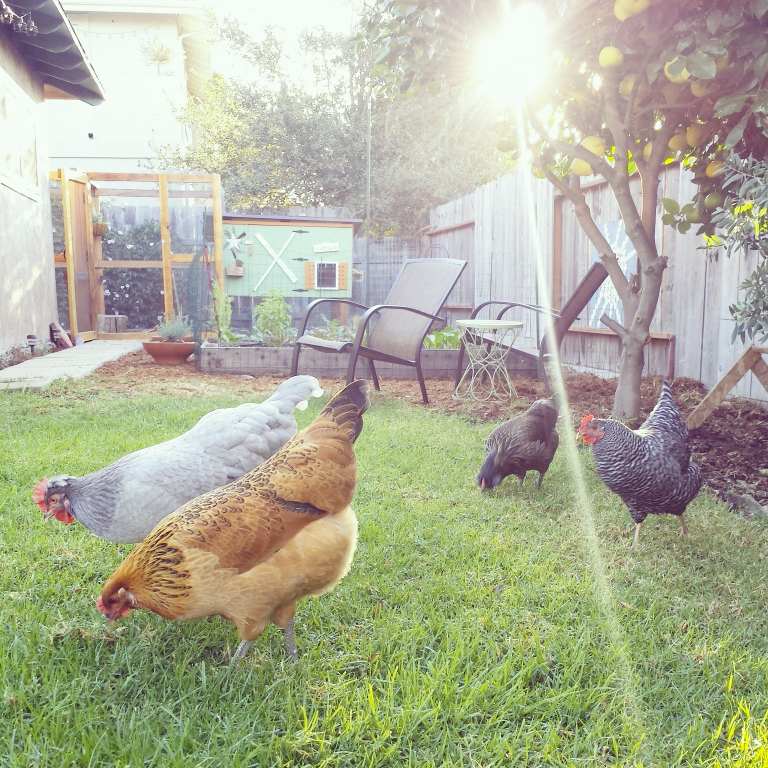
Peach, Olive, Dottie, and Hennifer, circa 2014.
14 Essential Things to Consider Before Getting Backyard Chickens
Since we’ll cover a lot of material today, here is a breakdown of the sections. Click on any topic to skip right to it!
- Local laws and ordinances
- Starting with hatching eggs, chicks, pullets, or adults (plus breed options)
- Where to get backyard chickens
- How many chickens to get
- Chicken coop and run essentials (size, styles, nest boxes, roosts, weather-proofing, etc)
- Predators and predator-proofing
- Free range options & considerations
- Food and water
- Eggs (laying frequency, natural breaks, storage)
- Poop
- Daily Care
- Vacations and nights out (automated chicken coop doors)
- Health issues and emergencies
- Planning for the future
1) Local laws and ordinances
If you’re in an urban or suburban setting, does your town allow for you to keep backyard chickens? What about if you live in an HOA? Do the bylaws permit it? If yes, that’s great! Are there any restrictions set forth, like setbacks from neighbors or a maximum number of birds? For example, our town allows up to 14 chickens, but no roosters. All of their confined habitat (run and coop) must be at least 15 feet from any neighboring structures.
Sometimes it can be tough to find the right documents that spell out the rules. Ours is under our City Municipal Code public welfare section. Maybe try to Google “(your town/city) poultry ordinance” to find it.
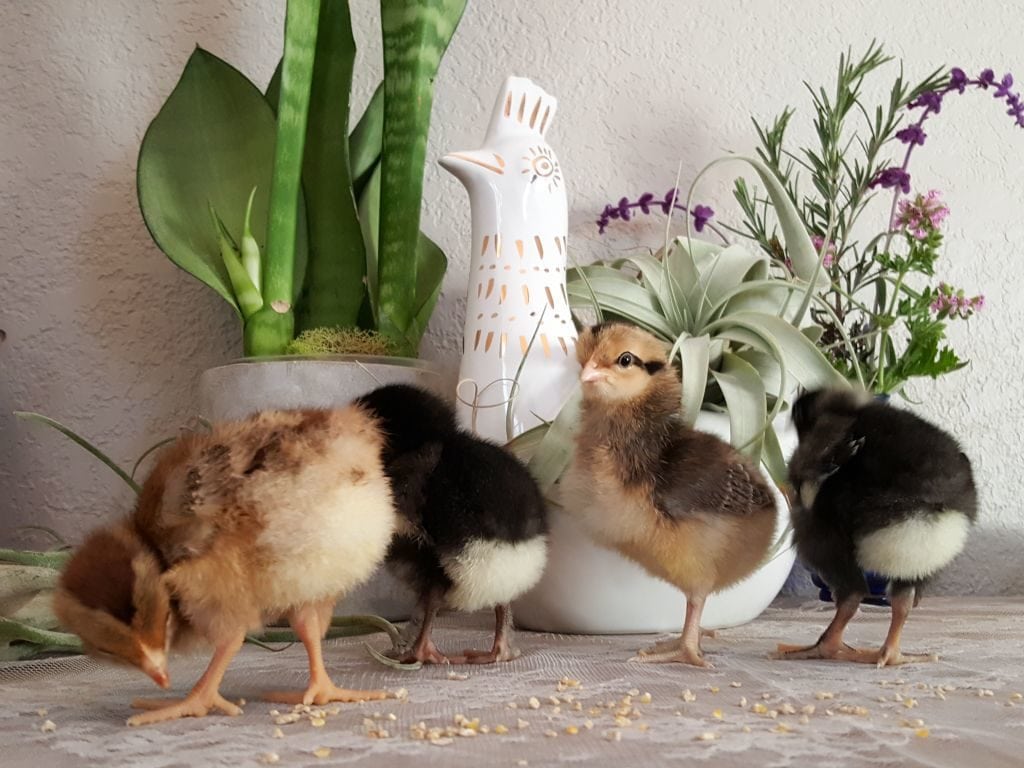
Our three-day old little monsters-in-training. Squee!
We have always started with day-old chicks.
2) Should I get hatching eggs, day-old chicks, teenagers, or adult birds?
Hatching Eggs
We haven’t incubated eggs at home (yet), so I don’t feel comfortable providing too much advice on how to do so. If hatching eggs is an option you’re interested in, check out this excellent guide from My Pet Chicken! Personally, I feel this might be an overwhelming option for someone brand new to raising backyard chickens.
Some of the benefits of this option include: no stress for the birds during shipping, a large selection of breeds to choose from, and a fun learning experience for the kiddos, and you! The possible drawbacks are: potential to deal with rare complications, deformities, or even deaths during incubation or hatching; less control over the sex of the bird compared to other options; plus the additional equipment, time, and knowledge needed.
Chicks
With day-old chicks, you’ll have the best opportunity to form a strong bond with those stinky little buggers. Plus… the cute factor! If you have kids, they’ll be SO excited to have baby chicks around! If you go this route, you’ll need to plan on having a brooder set up while they’re small, before they’re old and feathered enough to transition outside to the “big girl coop”.
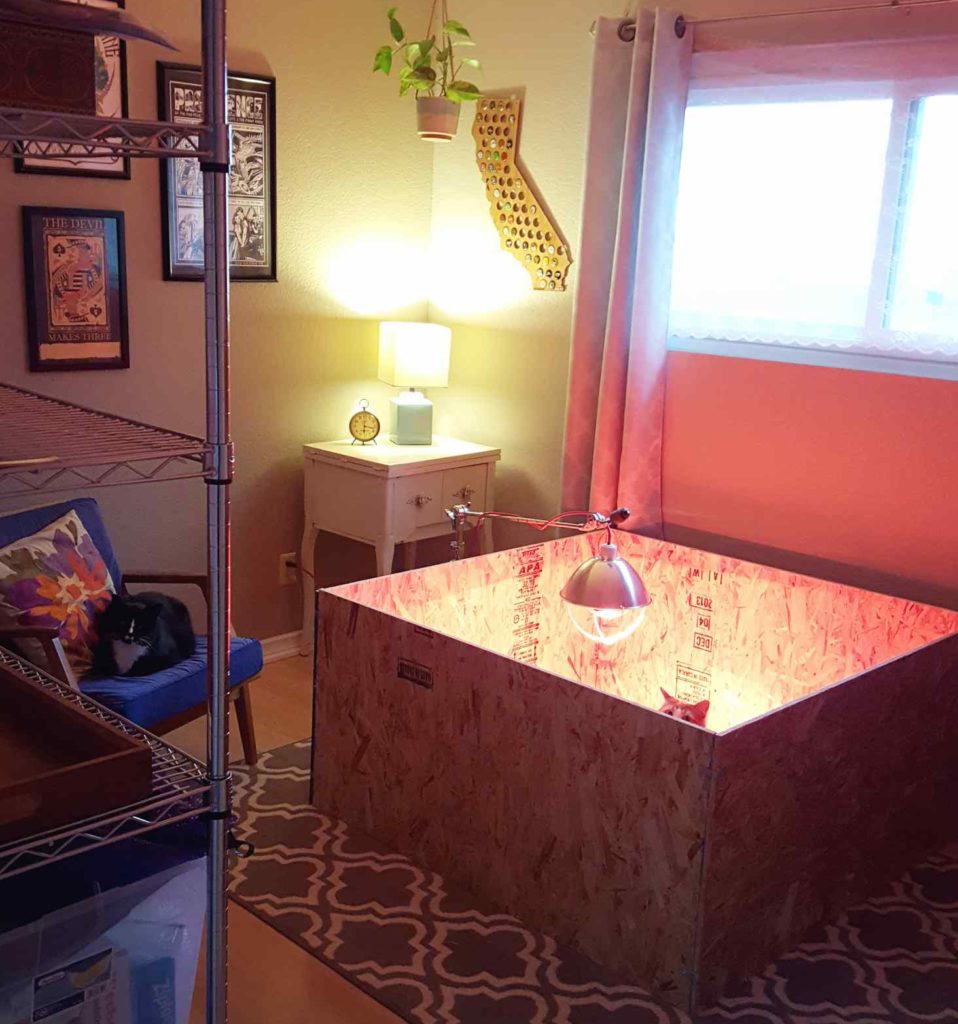
If you aren’t familiar with the concept, a brooder is a little protected enclosure, as simple as a large plastic tote, pop-up pen, or plywood box. We have used all three!
The brooder needs a safely-installed heat lamp to provide them the right ambient temperature for each stage of growth. We have used basic heat lamp fixture with red bulbs in the past, but they can be very worrisome and do run the risk of causing fires if they fall over or have other mishaps. We have since learned of a much safer option. Next time we set up a brooder, we intend to use one of these radiant-heat stands that chicks duck under, just like they would a mama hen. All my crazy-chicken lady friends swear by it!
The brooder will need a daily clean-up, along with frequent food and water changing, to keep them happy and healthy. For more details about setting up and maintaining a chick brooder, and other baby chick tips, please read: Baby Chick Care 101: Brooders, Heat, Health & More.
Teenagers
If fussing over a brooder and having tiny pooping creatures in your house or garage doesn’t sound like your cup of tea, you may want to consider getting slightly older chicks, called pullets. Pullets are female chickens that are approximately 8 to 28 weeks old. Basically, they’re fully feathered (hence, no need for the brooder), you can tell their sex 95% of the time by now, but they have not yet started laying eggs.
Pullets can be kept outside without heat from the start. That is, as long as they are fully feathered and it isn’t freezing outside. There is still a great chance of forming a close bond with them if you put in some dedicated hang out and treat time!
Adult hens
Maybe the extra work involved with younger chicks sounds like too much, you want fresh eggs right away? If having a super strong bond with your backyard chickens isn’t all that important to you, then getting adult hens may be the way to go!
It would be most wise and simple to get a handful of birds that were already together, if possible. Introducing new birds to each other is a whole other topic for another post, but the short and sweet is: it can be tricky. Merging flocks needs to be done carefully and right, including a quarantine process and gradual (supervised) introduction process. The pecking order can be brutal! Especially with adult birds from different flocks, or when introducing chicks to adults. Chick-to-chick is a little easier.
Breed options and egg colors
No matter if you get chicks or adult hens, be sure to pop over to this post on The Top 18 Backyard Chicken Breeds! It’s a subject all of it’s own. Your decision between breeds will depend on what your motives are (e.g. eggs vs appearance), where you live (some breeds are more tolerant to extreme heat or cold than others), and also somewhat dictated by where you get your chickens – discussed next.
3) Where to get backyard chickens
There are many options of where to get chicks or chickens, and pro’s and con’s to each option. Let’s briefly explore each, shall we?
A Hatchery
Overnight mail delivery of day-old chicks is available through several large commercial hatcheries in the U.S.
Pros: There is generally an extensive choice of breeds to choose from. It is possible to get all females, but not guaranteed. Most hatcheries claim to be able to determine the sex of young birds at a fairly high accuracy, but be advised that mistakes do happen! We have been lucky and received all females both times.
Cons: As with any large-scale animal operation, there is potential for sketchy and sad treatment of the adult breeding birds. Male baby chicks are usually culled. If you want to help reduce that practice, you can order “straight-run” (a random mix of sexes) instead of female-only, but you better have a good, humane plan for any roos you end up with! No, that doesn’t mean “setting them free”, or even putting them on Craigslist as “free to a good home” – unless you can really vet and trust that potential taker.
Commercial hatcheries may have potential for more health issues due to large-scale operation and breeding, and you don’t get to see your bird and choose based on vitality and behavior. Lastly, shipping causes some distress for the just-hatched chick.
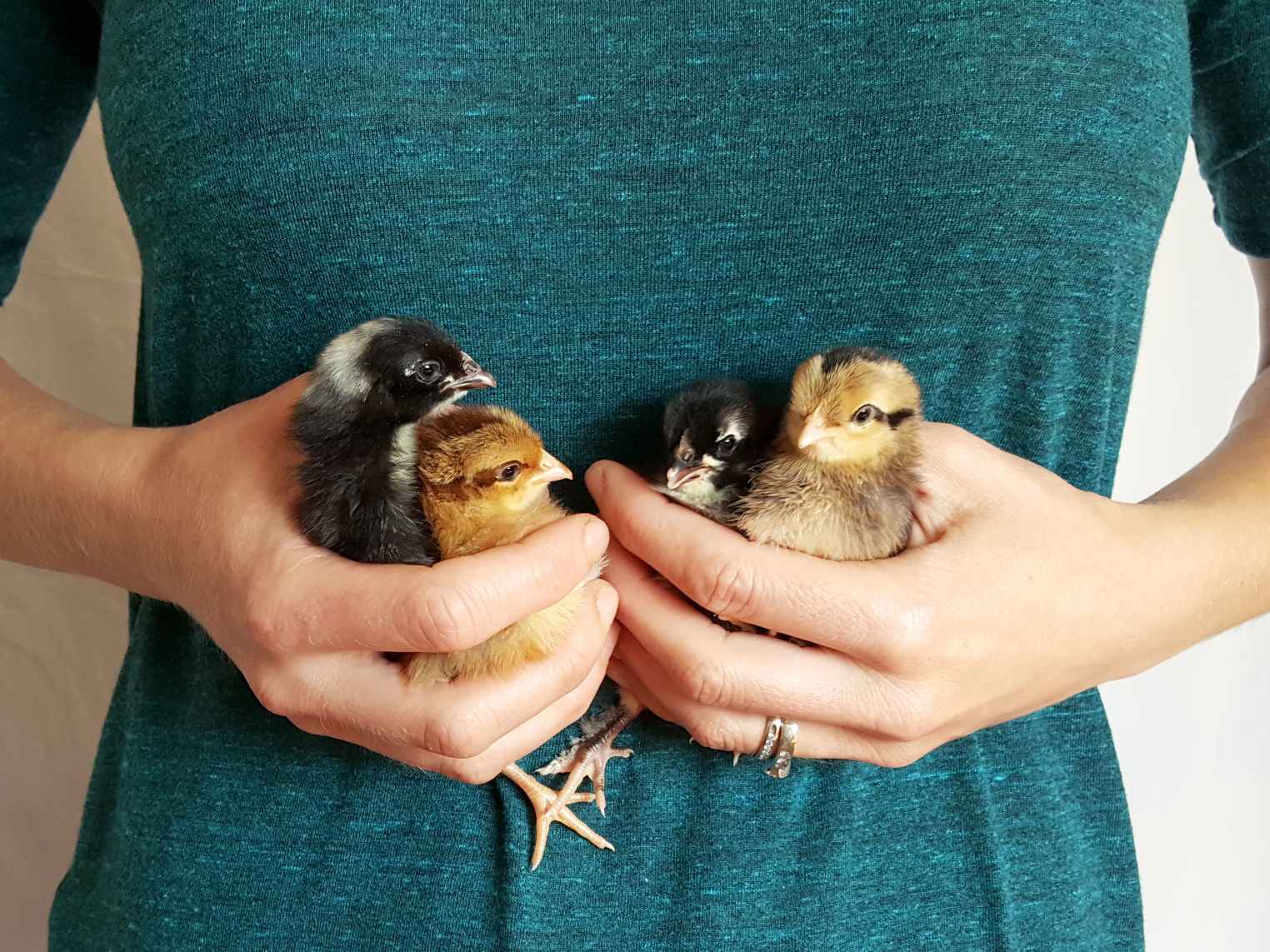
Local Tractor or Farm Supply Store
Pros: You can actually see the birds and pick out the cutest, fluffiest, quirkiest one yourself! Which can be especially fun for the kiddos. If you peer into their brooder and they all look dead, don’t freak! They sleep like dead things. Wait a few minutes and they’ll be bouncing around like fuzzy pinballs again. Another benefit is that they may have endured less stress thus far, if they didn’t have to get shipped.
Farm stores like Tractor Supply will usually have a spring chick calendar or schedule available upon request. It should tell you what dates they’re expecting chicks, and what breeds will be available when. Our local Farm Supply offers a handful of standard breeds routinely, with some specialty ones sprinkled in on a rotating basis. If you have your heart set on specific breeds, scope out the calendar in advance to plan your pick-up day. They may even let you reserve some.
Needs more research: Your farm supply store might get chicks from a local breeder (described below) or possibly from a large hatchery, which we already discussed. Then all those same pro’s and con’s to those two options would apply. You’ll have to ask them!
Local Farm or Local Breeder
Do some research into what is available in your area! For example, we have several small-operation poultry breeders within a few hours driving distance, that offer everything from hatching eggs to adult birds.
Pros: Like a farm store, you can usually pick out the specific birds, based on attitude and appearance. Plus, there is no stress of shipping. With this option, you’re supporting a local operation! Also, the chickens are most likely receiving better care and habitat than big commercial operations.
Cons: There may be fewer breed options to select from. You may have less ability and likelihood to get females only, if that is what you desire.
Learn 5 ways to tell the difference between young male and female chicks here.
An Animal Rescue, Shelter, Craigslist, or a Friend
Pros: Rehoming a bird in need of a good home can be a wonderful and rewarding thing! Especially chickens rescued from nasty factory farm type operations – usually referred to as “ex-battery hens”. You could be saving a life! Since backyard chickens have become very trendy, there has been a steep rise in ones needing homes. They’re often given up by folks who were not adequately prepared for their little homesteading adventure – like you will be now!
To find chickens to adopt in your area, check out Santuaries.org or PetFinder. Depending on the situation, you may have a great new steady layer on your hands! Or maybe you’re just providing a safe haven for a new friend.
Potential Cons: While rewarding, taking in random or rescue birds comes with a little more uncertainty. Be aware that these chicken could have a questionable demeanor, especially if they were not treated well by humans. Chances are they may be a little skittish and less inclined to cuddle up with you, but likely not aggressive (unless we are talking about a rooster). An honest, responsible owner or adoption agency should be able to discuss the chickens demeanor with you – though this could change, including for the better, once they’re in a new happy home and feeling more relaxed!
When they first come home with you, ex-battery hens in particular may need a little extra TLC, and could have lingering health issues as a result of their previous circumstances. Here is an article all about what to expect when caring for ex-factory farm chickens.
With this option, you have less control over choice of breed, age, and could be more difficult to plan in advance for when and what will be available.
4) How many backyard chickens should I get?
Chickens are social creatures! They like to have a few friends around. You’ll need to consider your space to decide exactly many to have in your flock, because the last thing we want is too many hens in the henhouse. Gossip, cliques, and drama WILL ensue! When chickens are crowded and given inadequate space or entertainment, they get bitchy. They’ll pick on each other – sometimes to the point of causing injury. Let’s avoid that, shall we?
For the average backyard flock and family, I personally think four is a perfect starting number. With four backyard chickens, you’ll have more entertainment and eggs then you know what to do with! Three or five is good too! But starting with only two chickens is not advisable. What if, God forbid, something happens to one of them? The last girl standing will be really lonely and you’ll need to find her a friend ASAP, or maybe have to consider responsibly re-homing her.
5) Chicken coop and run essentials
One of the most important and impactful things you’ll ever do for your future beloved backyard chickens is to provide them a safe, secure, and comfortable home.
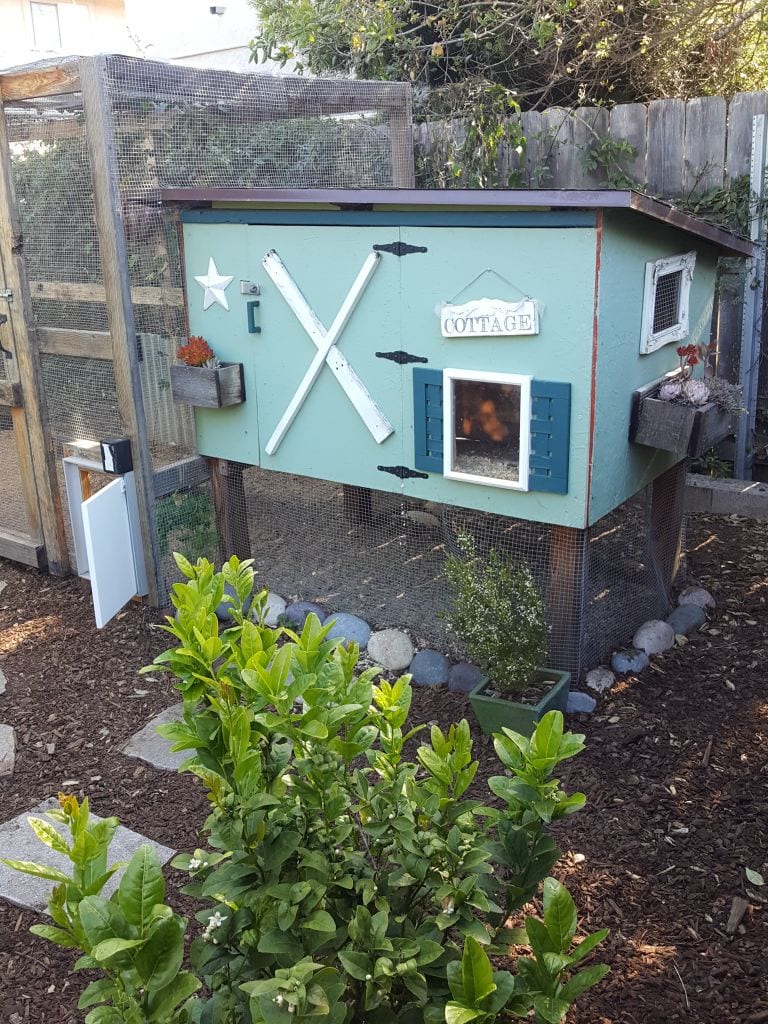
Chicken coop size minimums
The recommended size for a coop is 3 to 4 square feet per chicken, minimum, and about 10 square feet per chicken in the run space. For reference, our coop is 5’x3’ (15 square feet) and comfortably houses 4 to 5 backyard chickens – the maximum we’ve ever had in it. Do keep in mind that our girls only sleep in their coop. We don’t have “real” winters or snow here, so there is never a time they need to stay “cooped up” inside. (See what I did there?) Our attached, fully enclosed run is 30 feet long, 5 feet wide, and 6 feet tall.
If you have severe winters, plan to have a coop that’s large enough for extended stays, with room for food, water, and maybe even a heat panel inside. A coop that you can walk in to might even be preferred in that situation.
Avoid the minimum coop and run sizes so you can eventually expand your flock, because you inevitably will want to! It is called chicken math. Yes, it’s very a real thing. Urban Dictionary even says so.
Pre-made coops
There are some reaallly nice pre-made coops out there! I’ve also seen ads for local custom-built ones. Yet be leery of the little pre-made coops you may see at Costco or Farm Supply that cheerily claim are “designed to house up to four chickens!”. They are often times a bit tiny and sad. Tiny and sad for the birds, and tiny and sad for you to access and clean.
The number one regret I hear from people regarding backyard chickens is that they wish they’d built their own coop, or had something bigger than those little things. That, or wishing they’d better predator-proofed their coop and run, because they didn’t, and experienced a horrendous incident. We will talk about predator-proofing in a just a minute.
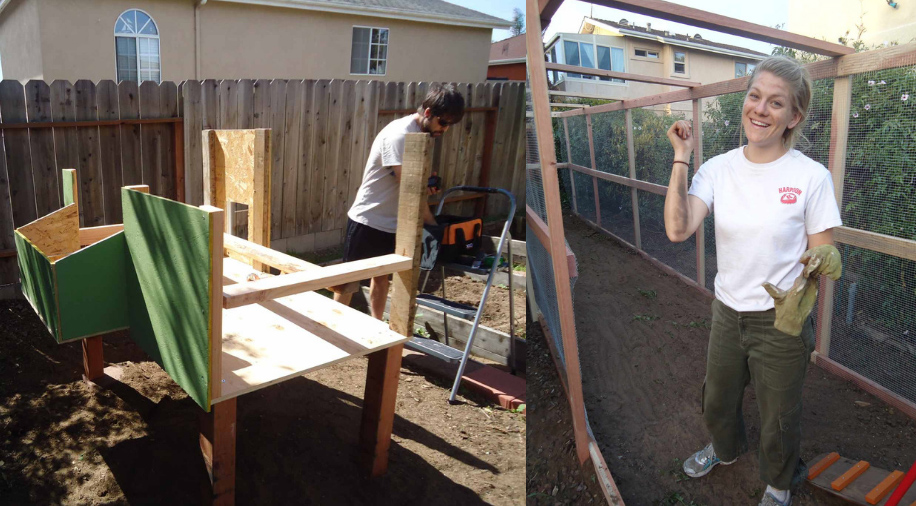
Building your own chicken coop
We had little-to-no experience building things when we made ours – it was one of our first-ever homestead projects! It was fun, fairly easy, and because we used a large amount of reclaimed and up-cycled materials, quite inexpensive. Especially compared to large pre-made coops.
If you aren’t up for building a structure, you could get a pre-made shed and convert it by adding nest boxes, chicken-size doors, vents or windows, and roosts as needed to make it coop-like. 2023 update: We moved to a new property and inherited a shed-style coop. Check out our original coop in video tour below. Also, here is a collection of 44 buildable chicken coop plans.
Our Coop and Run Tour:
Check out our YouTube channel for more videos by clicking here!
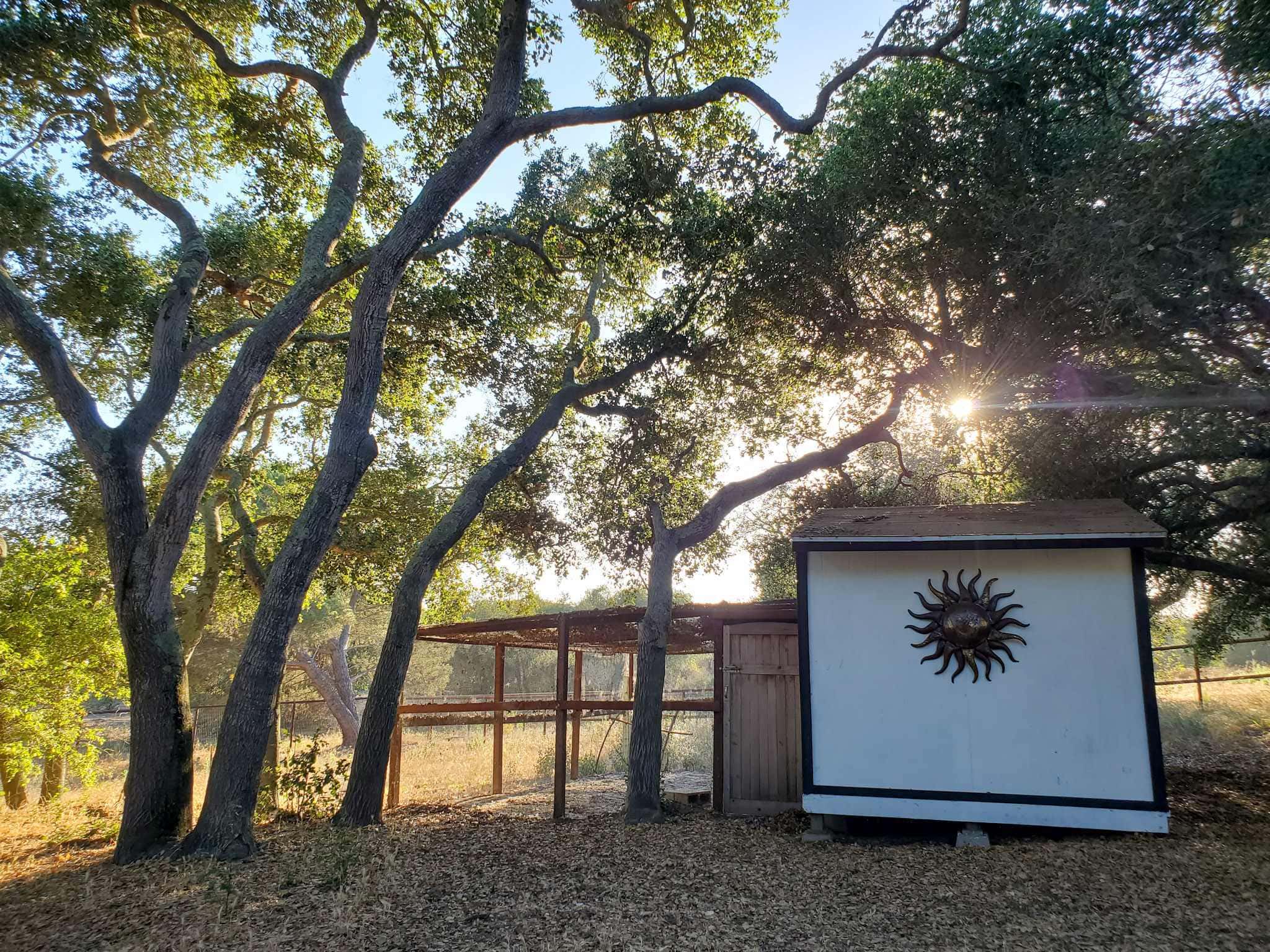
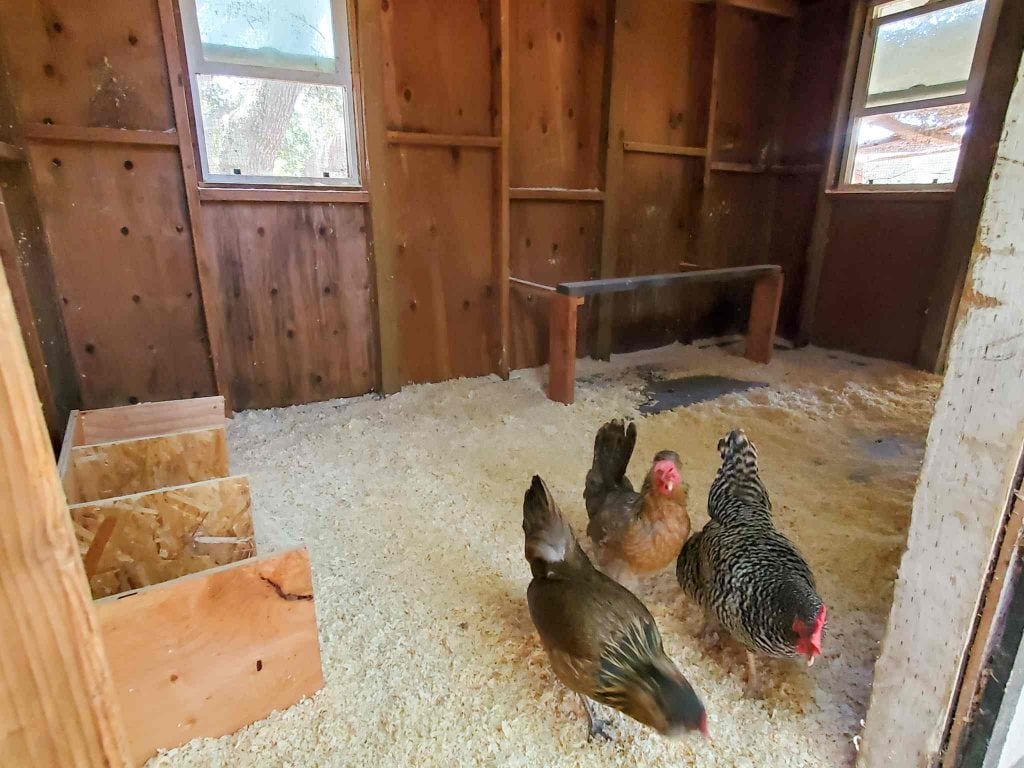
Nest boxes
Inside their coop, backyard chickens need a designated, safe, comfortable place to lay their eggs. They are referred to as “nest boxes”. The average size for a nest box is about 12″ x 12″ x 12″. How many nest boxes should you have? Experts say 1 nest boxes per four or five chickens is good. I would plan on two nest boxes for a small backyard flock. Even if you had one box per bird, they always want to lay in the same one anyways! A queue line or shoving battle will even form for the preferred box, even when others are empty and available. Silly, silly birds.
Line the bottom of the nest boxes with a soft bedding material that they can nest into. Something like straw or hay. Chickens push around the bedding material while they get situated in the nest. This can then expose the hard wood surface below. If they drop an egg there, it may break. To solve this issue, we line the bottom of their nest boxes with these awesome nest box pads that stay in place, and then put straw on top.
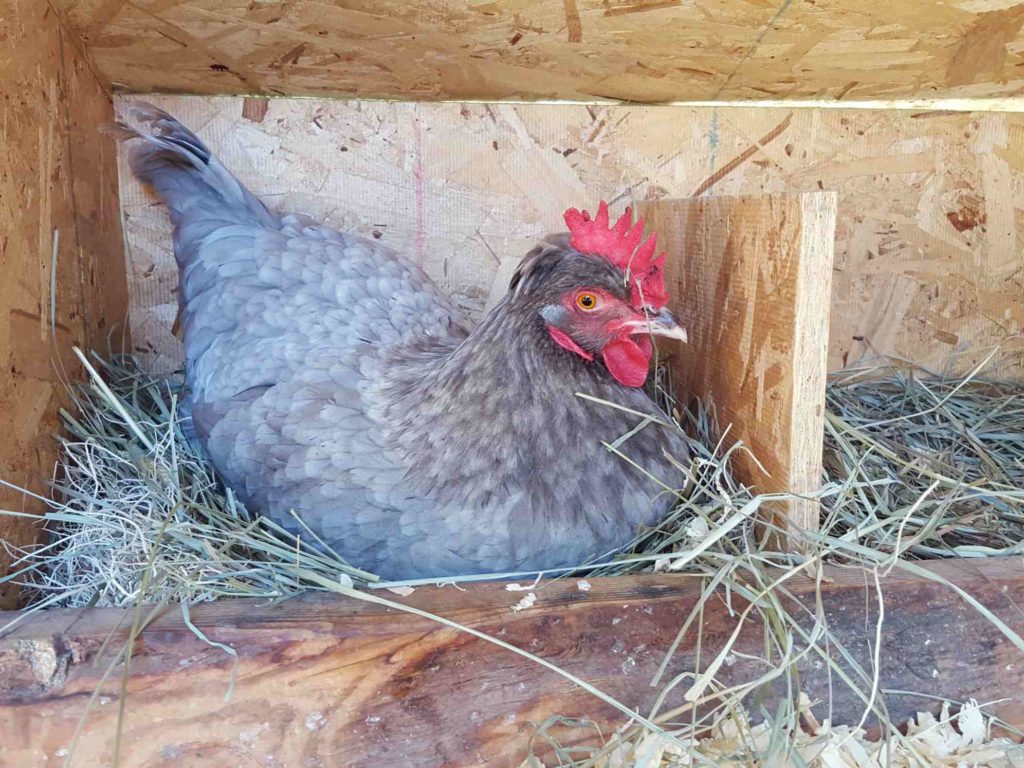
Coop Roosts
Their roost, the bar or perch that chickens sleep at night, should be the highest thing in their coop. At least 6-12” inches off the bottom of the coop, up to several feet tall, depending on your coop design. Though I am not a chicken, I feel that a flat perch (like a 2×4″ board on its wide side) would be more comfortable to hunker down on than trying to grip a rounded dowel or branch all night. Ours is a 2×4″ board.
It is essential for the roost to be taller than the nest boxes. (But NOT directly above the nest boxes, because guess where their little nighttime poops will land?!)
As as natural self-defense mechanism, chickens will sleep and roost on the tallest thing available. So if you put their nest boxes at the same height or above the roosts, guess where they’ll sleep? In the nest box. Thus, guess what will be all over your precious eggs? Poop. Yup, we’ll talk alllll about poop, real soon. This is one of the issues with some of those little pre-made coops. The roost is usually right at the same level as the nest boxes, maybe an inch or two above, causing the chickens to sleep in the wrong place.
Location
Ideally, the coop and particularly their daytime run/range space should have some sun, and some shade. If you can plan a run area with a tree in or around it, they’ll thank you endlessly! Our girls love to hang out under the canopy of trees and shrubs all day. They feel most secure there, and also rely on shade to help stay cool during hot weather. Chickens prefer sunny spots for dust bathing, along with stretching out in the sun on cool days to warm up.
Dust Baths
As counterintuitive as it sounds, chickens keep themselves clean by wallowing in the dirt. By laying down in the dirt, digging themselves a little hole, rubbing around, and fluffing their wings, they take a bath – called a dust bath. The process helps keep their feathers protected and waterproof, removes excess oil, and eliminates parasites. It is essential in chicken health! They will also preen themselves, rubbing their beaks on an oil gland that is located above their tail area, and disperse the oil around their feathers, further waterproofing them and providing insulation.
Chickens especially love fine, sandy soil for dust bathing. Some folks add wood ash, diatomaceous earth, or lime to dust baths for extra control against parasites like lice or mites. We provide our girls a designated spot to take their baths. It also helps reduce the number of holes they dig in the yard. We use these galvanized tubs filled with our native sandy soil (you could buy sand if needed) and added holes in the bottom for drainage.
Learn more here: How to Make a Chicken Dust Bath: Easy DIY Ideas
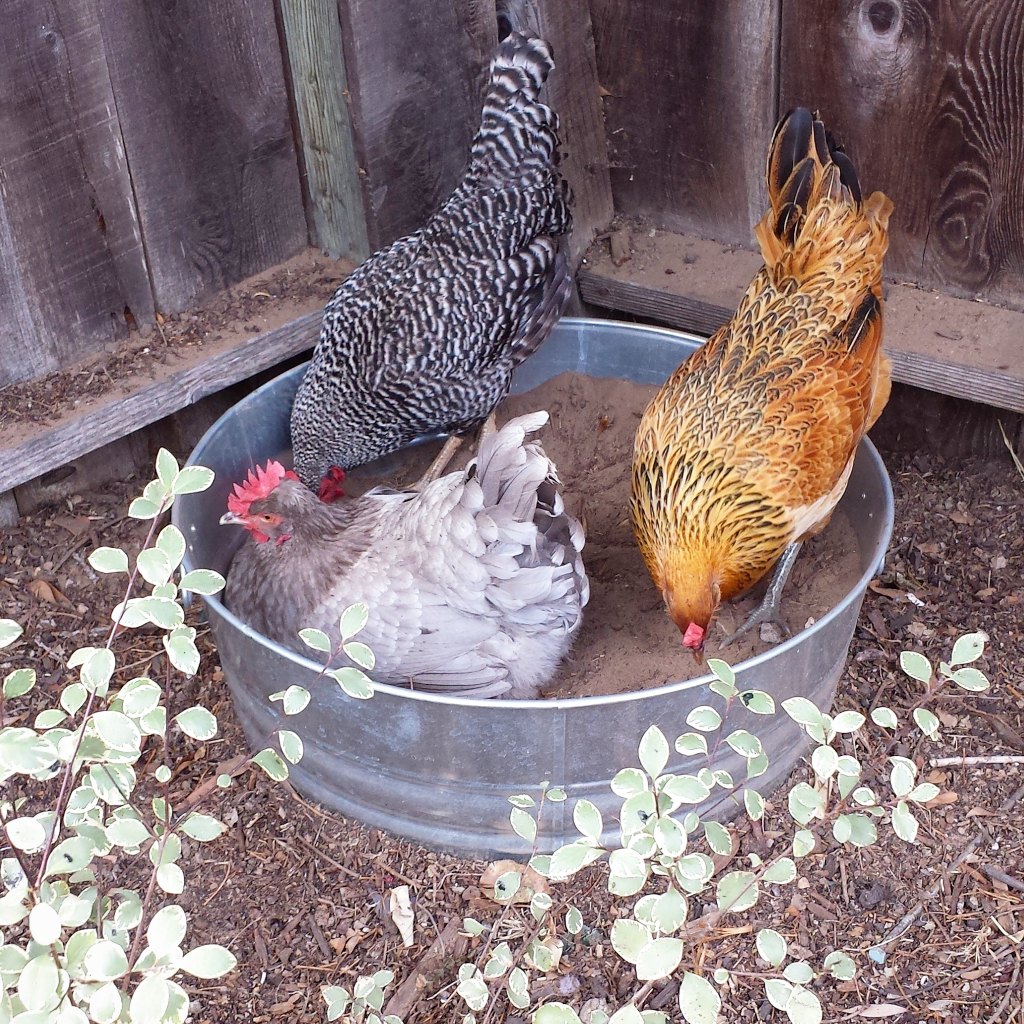
Weather Considerations
Cold
A chicken coop needs to be weatherproof, meaning it can withstand a good windstorm, doesn’t get wet inside during rain, and if you live in a climate with freezing winters, decently insulated. This doesn’t mean you need to install human house style insulation, but consider using slightly thicker wood, and not having tons of gaps between the wood for cold drafts. The girls will huddle together, and use their perfectly-designed feathers to keep warm.
Most times, artificial heat won’t be needed, though some people wrap up their coop and/or run in Tyvek or tarps during harsh winter weather to block drafts and keep heat in. Chickens with large combs and wattles are more susceptible to frostbite. They may need special care, such as putting vaseline on their combs. Some chicken keepers also use heating panels like these.
In addition to the coop, the run area should also have a semi “weatherproof” protected area for rainy days, for example a portion with a roof or shelter of some sort. One section of our run that is closest to the coop has clear plastic and fiberglass sheets of corrugated roofing material over it. This is mostly to keep their food dry below, as well as give them a dry place to hang out during occasional rain.
For more details, please see “10 Tips on Caring for Chickens in Cold Winter Weather”.

Heat
In summertime, chickens need a shady spot to hang out and stay cool. This is alone won’t be enough if you live in a place with intense summer heat. Temperatures over 95-100 degrees Fahrenheit can kill chickens, and does. Humidity makes it even worse. Yet people who do experience high heat regularly can still keep healthy, happy flocks of chickens! They just need to use a myriad of methods for keeping their backyard chickens cool, comfortable and safe. Fans. Shade. Water misters. Sprinklers. Kiddie pools for them to stand in. Air conditioning even.
The key is to lower their body temperature to avoid heat stroke, so providing cold treats for them to ingest like frozen corn, berries, or peas, or putting out ice water (and refreshing it often) is very helpful. If a chicken is showing signs of heat distress (laying down, panting, wobbling), you must lower their body temperature as quickly as possible. Do this by submerging their whole body up to their neck in cool, not cold, water. Though our weather is usually pretty mild here, we’ve had to dunk all our girls in a 5 gallon bucket a few times.
For more information, check out “10 Ways to Keep Chickens Cool During Hot Summer Weather or Heat Waves”.
Air flow
Chicken coops need to be well-insulated, but also need some fresh air circulation and ventilation. For example, through a couple small windows covered in hardware cloth, or some other protected vent system. Depending on your cleaning routines, it can get a bit stinky in there and built-up ammonia needs to escape, for their comfort AND health.
In places with “real” winter weather, when the chickens are cooped up inside more, those vents are essential to help release moist air along with the ammonia. This is important to prevent respiratory issues and frostbite. The air vents will also help keep things comfortable and temperatures down in the summertime, when the girls need to go back inside the hot coop to lay eggs. Keep the vents above the level of the birds near the top of the coop, since heat rises.
Entertainment and more roosts
Chicken keepers come up with creative ideas for “boredom busters” – entertainment to keep them happy and busy, especially in a confined run space. One example is hanging cabbages or wire baskets of greens at or just above beak height for them to pick at. There are also a variety of seedy treat-blocks that you can purchase, or even make your own! We get these ones on occasion – like when we are going out of town, which we’ll talk more about in a moment. The little blocks fit perfectly in a bird feeder suet holder that we hang from a tree or the wall of their run.
In addition to the roost they sleep on in the coop, plan on having some roosts in their run or in the yard they spend time in. Chickens love to nap, and napping on roosts is da best (says our girls). Or in a plump ball on the ground – the infamous “chicken loaf”. Sawhorses make GREAT roosts. I picked up a few at a garage sale, and we made one as well. It’s super easy to do! As a mega-roost, we assembled a branching “tree” in their run from the remnants of a dead tree we had to remove from the yard.
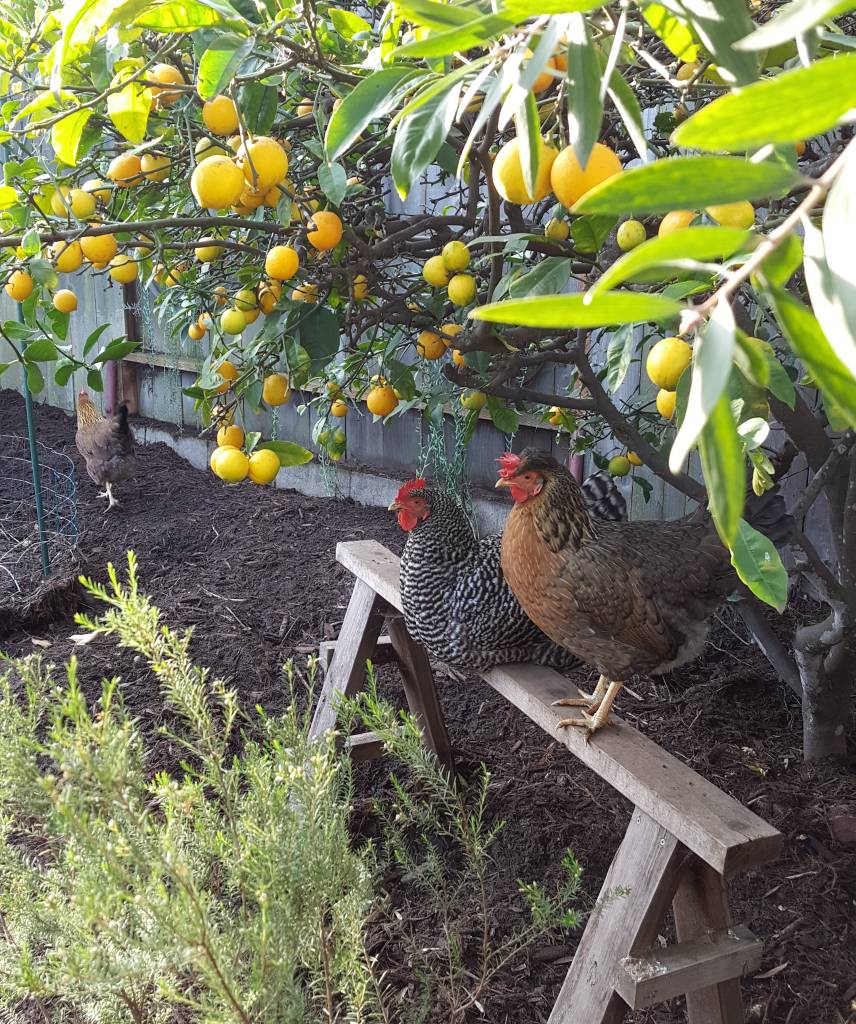
Flooring
The ground of the run can be anything from native dirt, sand, wood chips, pea gravel, or straw. You want something that has good drainage, so don’t put a run on top of a concrete slab for instance. Sand is nice because it’s kind of like kitty litter, and makes for easy work in picking up poop. Straw can keep a wet situation a little less soggy and muddy than just dirt alone, but can also get a bit messy with poop. If you go the wood chip route, avoid cedar. Cedar oils are reportedly toxic to chickens. We use a mix of shredded redwood mulch and small redwood bark in the back yard where they range, and coarse washed concrete sand in the run.
6) Chicken Predators
Predators to chickens include hawks, weasels, foxes, coyotes, raccoons, opossums, bears, bobcats, mountain lions, or other large wild cats. Snakes may try to eat chicken eggs. Cats are not typically a threat once chickens are fully grown. The birds are usually larger than cats by then, and startle them with their flapping and squawking! When raising baby chicks indoors, make sure you carefully monitor their interaction with your other larger pets.
Predator-proofing a chicken coop and run
The most important part of their habitat to strongly predator-proof is their coop. That is their safe-haven! While important, the protection of their run will depend on your situation, location, and how you intend to let them range. The best fencing material for predator-proofing is galvanized hardware cloth with ¼” openings. Despite the misleading name, chicken wire is too flimsy! It deteriorates with time and can be chewed or ripped through by predators like raccoons or bears.
Rodents can squeeze through pretty tiny holes, the size of a quarter, so make sure to take that into consideration when looking into fencing options. Mice and rats may not harm your chickens, but they’re a nuisance. You don’t want them in your backyard chickens’ space. They might try to eat eggs, and it is not sanitary to have them around the feed and water.
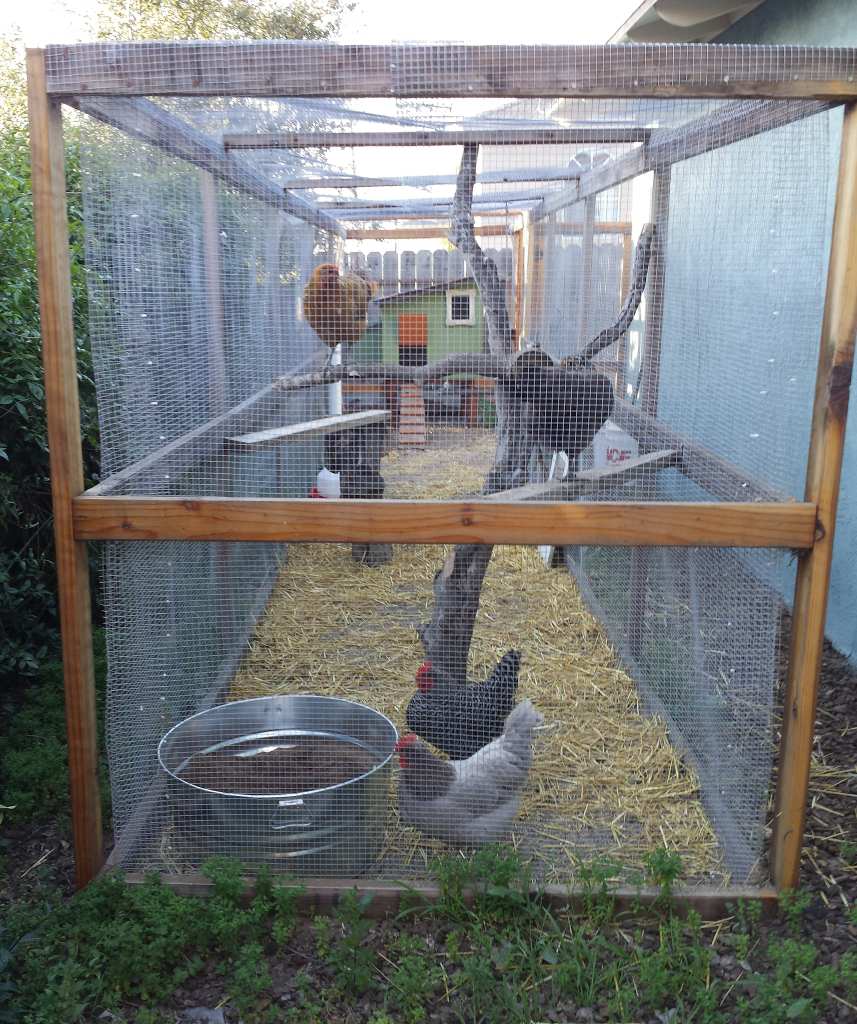
Every nook and cranny needs to be vermin and predator-proof, including around the outside perimeter at ground level! It is suggested to bury hardware cloth in a 1-foot deep “apron” around their coop and/or run. This is to prevent anything from digging under. (I say “coop and/or run” because again, this will vary depending on your setup.)
If you have a super predator-proof coop that the chickens are safely locked in at night, making a Fort Knox-style run may not be necessary. If there are little-to-no daytime predators around your property, a lightly fenced or totally free range area may be okay during the day. But if you have coyotes, bears, mountain lions, foxes, hawks, or eagles, plan for a fairly sturdy run too.
We have virtually no daytime predators, so our girls are able to safely free range the backyard during the day. They are locked away in their very secure run/coop combo at night. There may be a super rare occasional hawk flying high above our neighborhood, but our back yard has a good tree canopy around the perimeter that the girls spend 90% of their time under. Our yard is also long, narrow and fairly small, making it much more difficult for a hawk to dive in to.

7) Should I let my chickens free range?
Or, maybe only supervised free range? We already talked a bit about predators, but whether or not you have daytime predators isn’t the only factor to consider when determining what kind of ranging plan you want to enforce on your budding homestead. For example, if you hope to free range, do you have a garden, nice landscaping, or plants you care about in the same area you plan to allow them? If you answered yes to both, then you better add “plan to protect said garden” to that list. Or, plan to be out there supervising them during their range time.
Chickens are pretty much certified professionals at five things: laying eggs, being adorable, pooping, eating, and digging.
We read about this when we first got chickens, but didn’t really understand just how much damage they could do until after a good year in. They really liked to hang out (and poop) on our patio. We eventually fenced in that area to make a clean “poop free zone”, leaving them the rest of the yard to free range. With time and a little creative thinking, we came up with all sorts of hacks and tricks to keep our back yard beautiful, manageable, and useful, for both us and them. For example, strategically fencing certain areas (like around the base of young trees or garden beds) to protect them from digging and damage. I will write up a post dedicated to “Gardening with Chickens” soon!
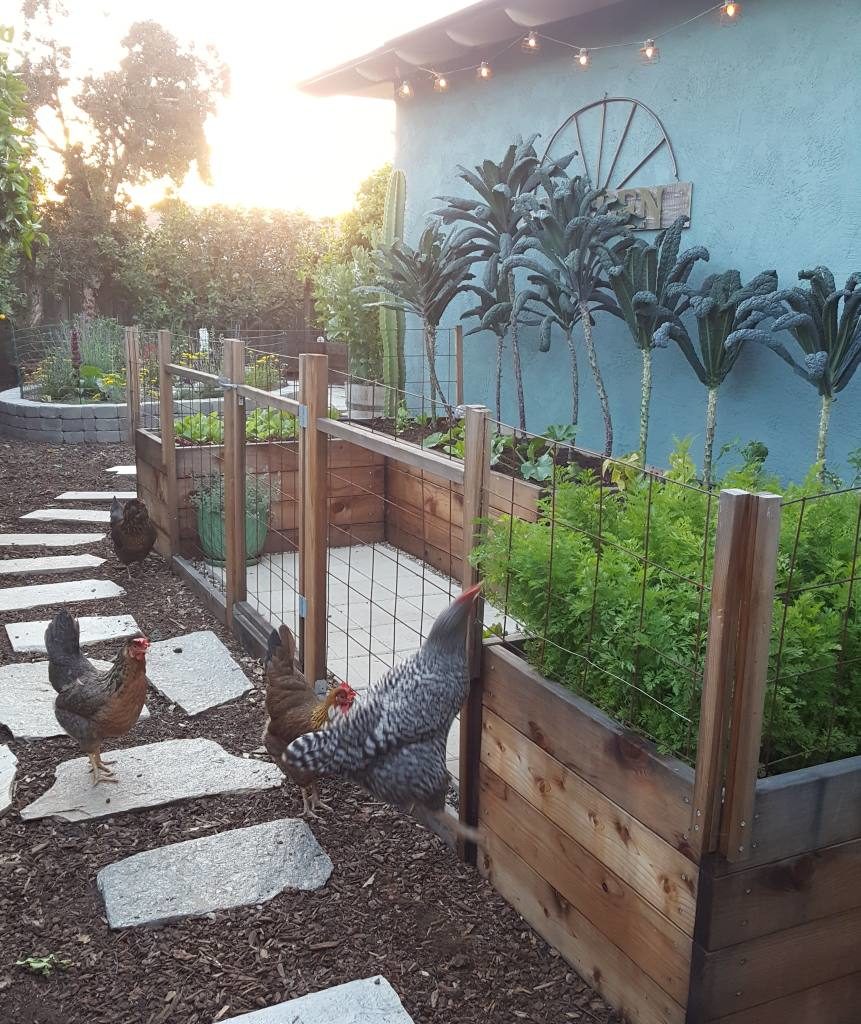
Chunnels
If you do have some daytime predators, or if you want to limit access to certain areas of your yard – you should consider chicken tunnels, aka “chunnels” – in addition to their run! Essentially, it is giving them their own little fenced chicken highway around designated areas of the yard, rather than needing to fence in everything else. Depending on their design, chunnels could be rotated periodically to different locations. They could also be easily made against an existing fence or around the perimeter of a yard.
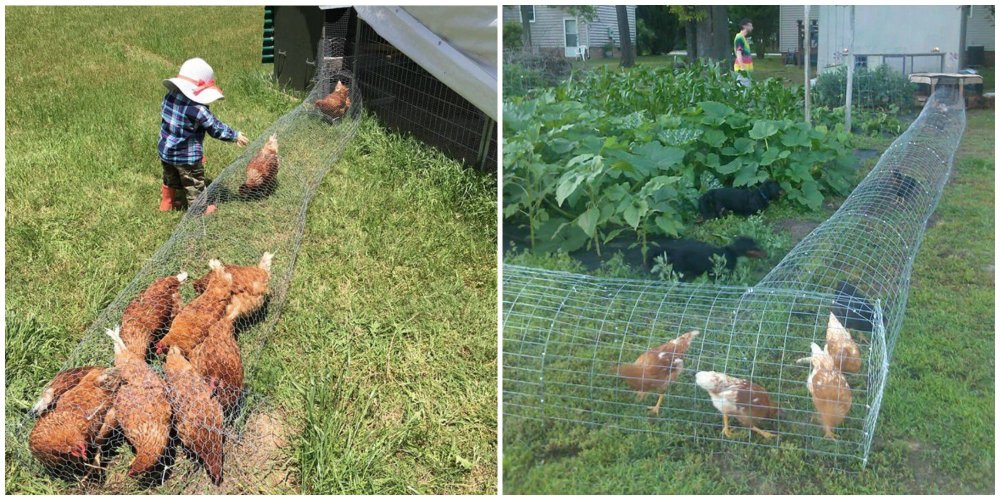
Photo courtesy of County Living
Other Ranging Considerations
Don’t want fences at all? Do you have a huge property that they can just run a muck on, or you simply don’t care if they do a little damage? Even if so – do not plan on free-range only, without having some kind of backup plan. Meaning, do not only plan a coop and skimp on providing a safe run because “they’re just going to free range anyways”. Even though our girls free range all day e’ry day, we still have a large run we know we can safely tuck them away in to if needed. For example, during a storm, unexpected predator issues, when we got our house re-roofed, or if we needed to replace a fence in the backyard – like we need to do soon.
Last but not least if you are considering free range, do a mental and physical inventory of the space they will have access to. Are there any dangerous materials around, like rat bait or gopher poison? Has the grass they may graze on been recently treated with pesticides or fertilizers? Are there any sketchy crevices, sharp objects, or places they can get stuck or into trouble? Think of it like toddler-proofing. Chickens are pretty much toddlers – they’ll put just about anything in their beaks they can can.
8) Food and Water
Feed choices
Baby chicks, pullets, and laying hens all have different feed requirements. “Starter” and “grower” feeds for younger birds have more protein to support rapid growth. Layer feeds have slightly less protein, and a little extra calcium. There are a ton of options for chicken food out there, including making your own blend. If you choose to do so, ensure you find a recipe that gives them all the nutrition they need! We prefer to leave that to the pros, and give them this organic, non-gmo Scratch and Peck layer feed. The girls love it! We also ferment it for them on occasion, for an extra boost of nutrition and probiotics. I will write a post on that later.
Calcium
Once they’re laying, you’ll also need to put out a free-choice calcium source (like crushed oyster shells or egg shells) to support healthy eggshell development. This is essential. Eggshells themselves are made up of calcium carbonate. Without enough of it in their diet, they can end up laying soft-shelled eggs or even have them break inside. This leads to serious health issues!
By free-choice, I mean a small dish separate from their food that they can choose to eat as they feel necessary. Yes, feeding them back their own eggshells is okay. More than okay! Our girls prefer baked and crushed eggshells over oyster shells any day. Plus… they’re FREE!
To read more about providing calcium to backyard chickens, and how we prepare baked crushed eggshells or oyster shell for our girls, see this article all about it!
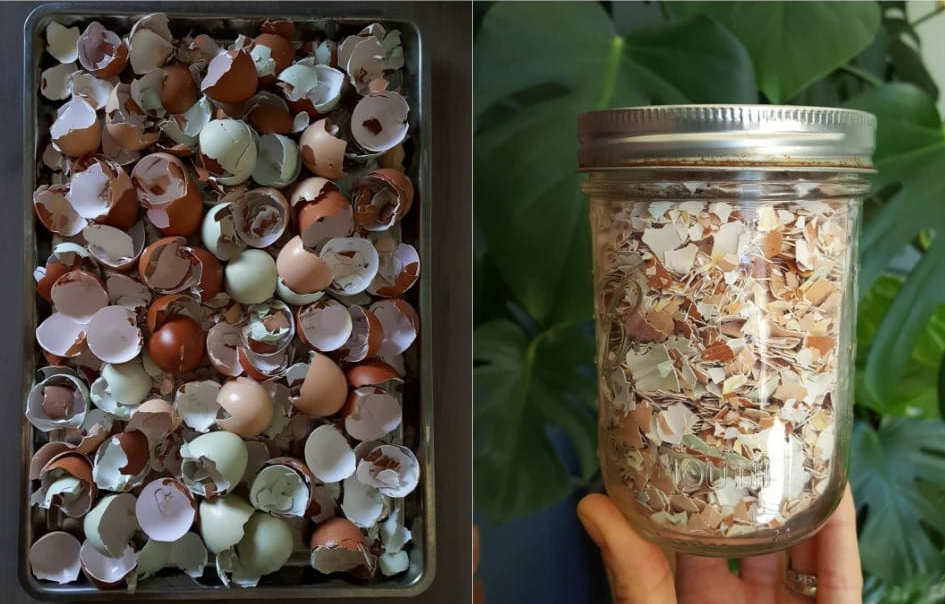
Food Availability, Bio-security, & Storage
Fresh feed can be put out daily, which is favorable but a little more work. Or it can kept out all the time, as long as wild animals can’t get to it, especially overnight. This isn’t only because we don’t want to share with the wild ones. We also don’t want their potential cooties. Wild animals (including other birds) may carry parasites or diseases that could be transmitted to your backyard chickens. By keeping their food away from wildlife, you are practicing good bio-security.
Food also needs to be refreshed often enough to prevent it from getting moldy and stale. Our girls have a feeder that is in kept their pest-proof run, which we refresh a couple times a week.
Bulk food should be stored in a dry, vermin-proof container. We keep all of our chicken food, treats, and miscellaneous supplies in a dedicated large storage tote in the garage, sealed with a secure lid. Rodents are not an issue in our garage. If you keep chicken feed outside or in a shed and have minimal wildlife activity, consider a heavy-duty, BPA-free, plastic container like this one. If you need a little more protection, you could use a galvanized metal container like this one. They’re both made in the USA!
Water
Fresh, clean water needs to be available at all times. Like their feed, it should not be accessible to wild animals (to the best extent possible). Our girls have one water container in their run, but also one in the yard that wild birds may drink from on occasion, so we take extra diligence to clean and sanitize it frequently.
One little trick that many chicken keeps practice is putting a little splash of apple cider vinegar (ACV) in their chickens water. Use 1 tablespoon of ACV per gallon of water. The slight drop in pH helps prevent it from developing harmful bacteria and algae as easily. It is also a great little probiotic and immunity boost for the chickens, said to help ward off everything from worms to respiratory issues! If you decide to implement this, ensure you’re using a plastic waterer. The vinegar is acidic and will negatively react with metal waterers, causing corrosion and leaching. We use this waterer in the run with ACV, and have another galvanized metal one out in the yard that we do not add it to.
Snacks
A backyard chickens diet should primarily consist of their layer feed, and whatever plants and insects they pick at while free ranging. As tempting as it may be, don’t treat them like your living compost system – throwing every scrap of kitchen and garden waste their way. This can throw off their nutritional balance, so only give snacks in moderation.
Our girls have a couple “snack bowls” out in the yard, in which we give them healthy treats in a few times a week. Examples of our girls favorite treats include: black oil sunflower seeds, organic dry rolled oats, mealworms, discarded sourdough starter, sprouted seeds and grains, and chopped up kombucha SCOBY. Of course, lots of garden greens too!
Avoid feeding chickens: dried beans, leaves or unripe fruit from the nightshade family (tomatoes, peppers, eggplant, potatoes), citrus, junk food or processed food, moldy or rotten food, avocado peels or pits, chocolate and candy. Some of these are obvious, some less so, but all are not good for chickens.
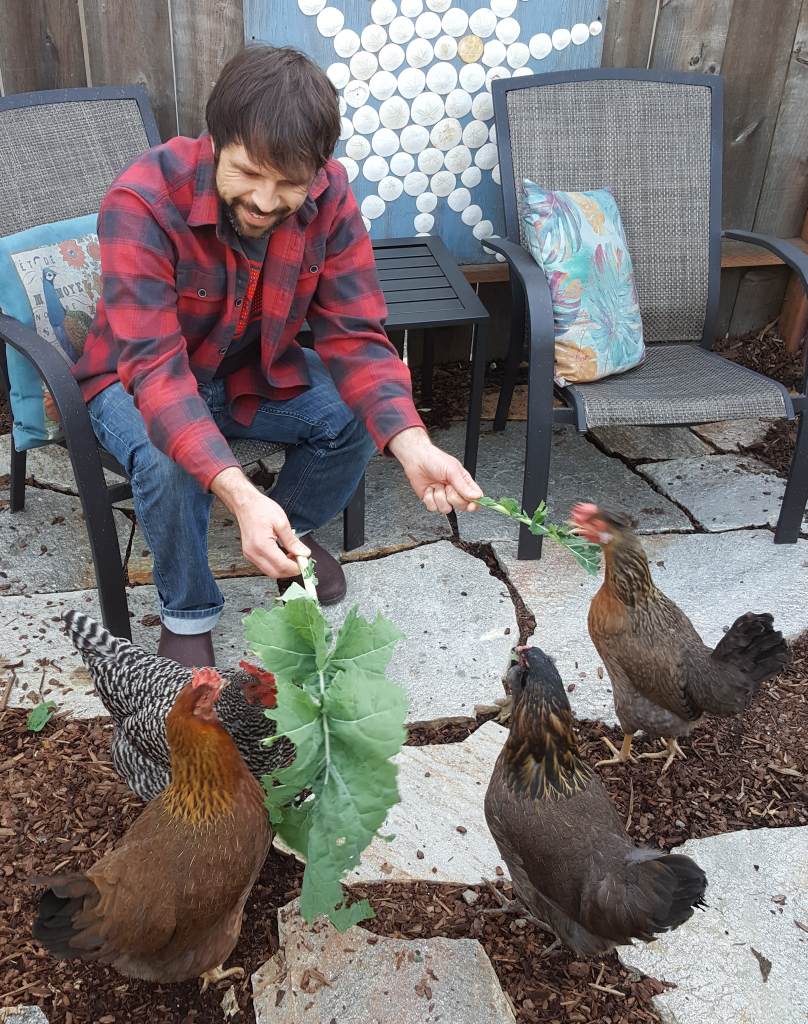
9) Eggs
This is why you want backyard chickens most, right? Fresh, ethical, delicious eggs, straight from your backyard! Store bought eggs, even “cage free” or “free range” ones got NOTHIN’ on fresh golden home-raised chicken eggs. If you haven’t had the luxury of seeing and tasting the difference yet, you’re in for a treat! Eggs certainly are a major perk of keeping chickens. For us, eggs are viewed as an additional benefit of having chickens, because first and foremost, we enjoy keeping them as beloved companions. However, I know that is not the case for everyone. If eggs are your primary motivator for getting backyard chickens, take note of the laying frequency of the breeds you’re interested in.
Egg Laying Frequency
Some chicken breeds may lay pretty much every day, some just a couple times a week, and everything in between. Most chickens “come into lay” or start laying eggs around 20 weeks old, but can range from as early as 16 weeks to as late as 30 weeks or older. Learn the tell-tale signs that your chickens will start to lay eggs soon here.
Chickens naturally take breads from egg laying from time to time, including over winter or while they’re molting (turning over new feathers). Read more about caring for molting chickens here. Younger hens may lay right through their first winter, but then usually stop during winter time as they get older.
Breaks are good and natural, as laying eggs is no easy task! This is their way to conserve energy and nutrients for more important things at times, like staying warm and healthy. Therefore, we do not support artificially lighting coops during the winter to promote winter laying on this homestead. Like human women, chickens carry only a set amount of eggs in their bodies from the time they are born until they die. So if you push them to lay all winter, they’ll just “run out” of eggs and stop laying earlier in life. We don’t mind a break from eating eggs ourselves, because honestly, sometimes we have so many that we get tired of them!
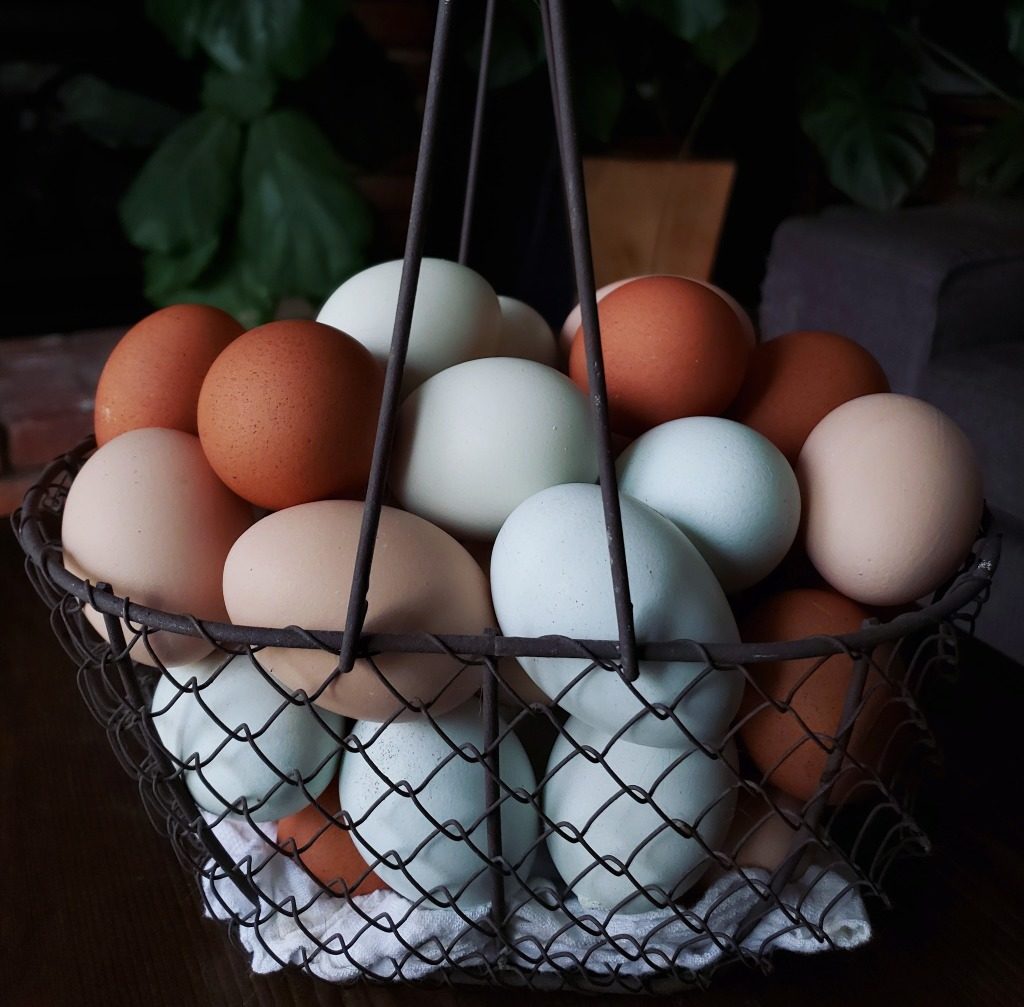
Egg Storage
When an egg emerges from the chickens cloaca – that is the name for their one hole (yep, they just have one hole) – it is coated with a “bloom”. The bloom is a natural coating on the eggshell that protects it from intrusion of bacteria. It also reduces loss of moisture from the egg. Therefore, unwashed eggs are safe to keep out at room temperature.
If you wash off the bloom, you’re washing off its natural protection. Therefore, washed eggs must be refrigerated to prevent bacterial invasion and spoilage. We store ours on the counter in a basket, and wash them immediately before use. If we aren’t going through eggs very fast and a pile builds up, we then move the oldest eggs to the fridge – the ones that have been out for a few weeks already.
Learn more about fresh egg storage and shelf life here.
10) Poop
Folks. I won’t even lie. The poop situation is pretty real. I literally just Googled “how often do chickens poop” because I wanted to dazzle you with a surprising statistic, but I came up short. Apparently no one has ever studied the frequency of chicken poop down to a science. But the commonly accepted answer is: a lot. At least a few times an hour.
Jokes aside, the severity of this “issue” is going to depend on your property and ranging situation. If you have only a handful of backyard chickens and a huge open field or large yard for them to free range in, the poop won’t be as noticeable. On the other hand, it will build up quicker in small spaces or with more birds.
Whether you have a small yard or a large one, if you have an accessible patio or deck area, they will hang out on that patio and stare at you through the sliding glass door, making eye contact as they poop on it. Ask me how I know.
In that instance, you can do manual pick-up, sweep (watch out for sweeping and schmearing the wet ones though!) or blast the space off with some high pressure water as needed. We used to do a combination of these, but here in California where water is scarce, the water thing wasn’t so sustainable. So we eventually fenced them out of “no poop zones”.
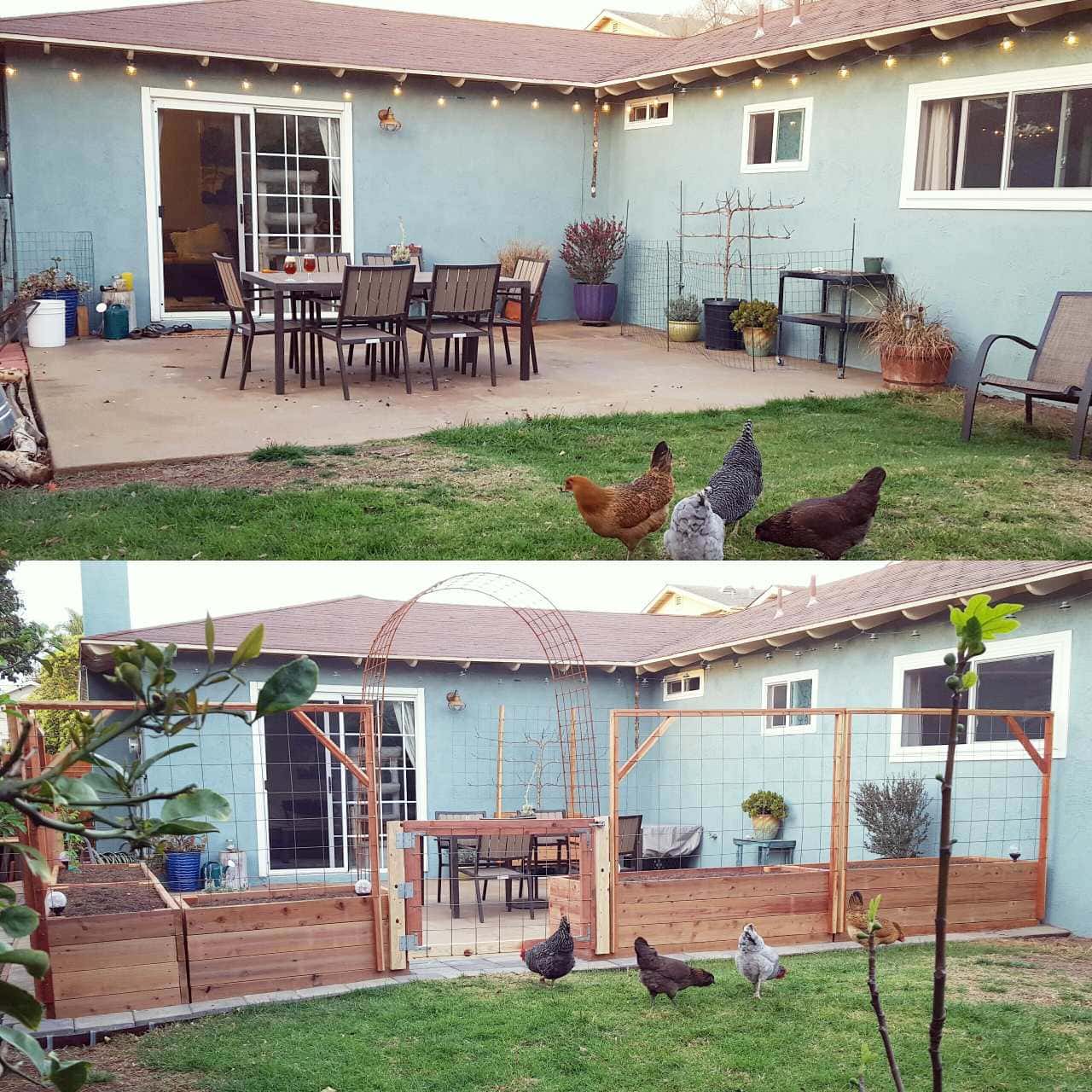
How do we handle the poop in the yard?
Well, the majority of the yard that they free range is just dirt, and covered with a layer of shredded redwood mulch and bark. They poop in said mulch, dig and churn it all up, and bury the poo. It is free fertilizer that will age in place around the backyard fruit trees!
For poops in their run, along our pathways, or otherwise noticeable or concentrated areas – like under their yard roosts – we do a weekly poop pick up with a glove and bucket. Yep. Kind of like for dogs. If you aren’t keen on the idea of bending over to do so, you could use a long-handled dog poop scoop. This frequency is more than adequate for the four feathered creatures we share the space with, though shit happens – we do still accidentally step on poop, plenty! It’s a good idea to have an easily-cleanable designated pair of “chicken yard” shoes like sloggers, plus a shoe scrubber near their space.
Poop in the coop
To handle poop in the coop, we implemented a “poop board”! It’s simply a thin but sturdy piece of plywood cut length of their roost, and about 18” wide. To make it easily cleanable, we wrapped and covered it in sheet vinyl to fit, glued on from edge to edge.
The board is situated under the roost, in a way that their butts will hang over it. Poop falls onto the board, and we can then easily scoop it up daily with a dustpan and wide paint scraper, disposing of the refuse into a nearby bucket with a lid. This keeps their coop nice and clean, and also keeps the bedding fresh for longer (we use pine shavings) – thus reducing waste, and reducing the need to do deep cleaning as often. If daily cleaning sounds like too much hassle, you could try the deep litter method.
What to do with their poop, including how to properly age and compost it, is a whole other discussion for another day. But for now I will just say this: DO NOT add fresh chicken manure straight to your garden. It’s too high in nitrogen and needs to be composted for a long time first.
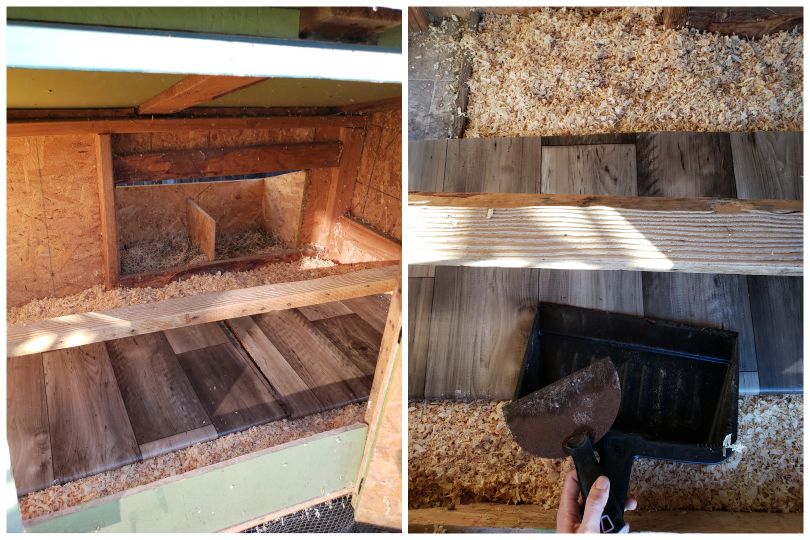
11) Daily care
Once your flock is established, the daily upkeep can be super quick and simple – depending on your set up and situation. Maybe you’ll want to let them out to range for a bit, refresh their food and water if needed, collect eggs, make sure everyone is looking healthy and happy, and always ensure they’re safely tucked into the coop at dark. (Automatic coop doors help make this a breeze, explained more in the next section!)
Collecting eggs on a daily basis is important to prevent possible breaking of eggs and egg-eating behavior. It also helps prevent them from going broody. That’s when a hen sits on eggs, trying to incubate and hatch them – even if the eggs aren’t fertilized. It isn’t ideal because the hen will often stay put, forgoing food and water, thus jeopardizing her health.
Give them some love and attention! Chickens are curious, energetic, and even affectionate animals. When you can, spend some time with your flock – catching up on gossip over a bowl of chopped kale.
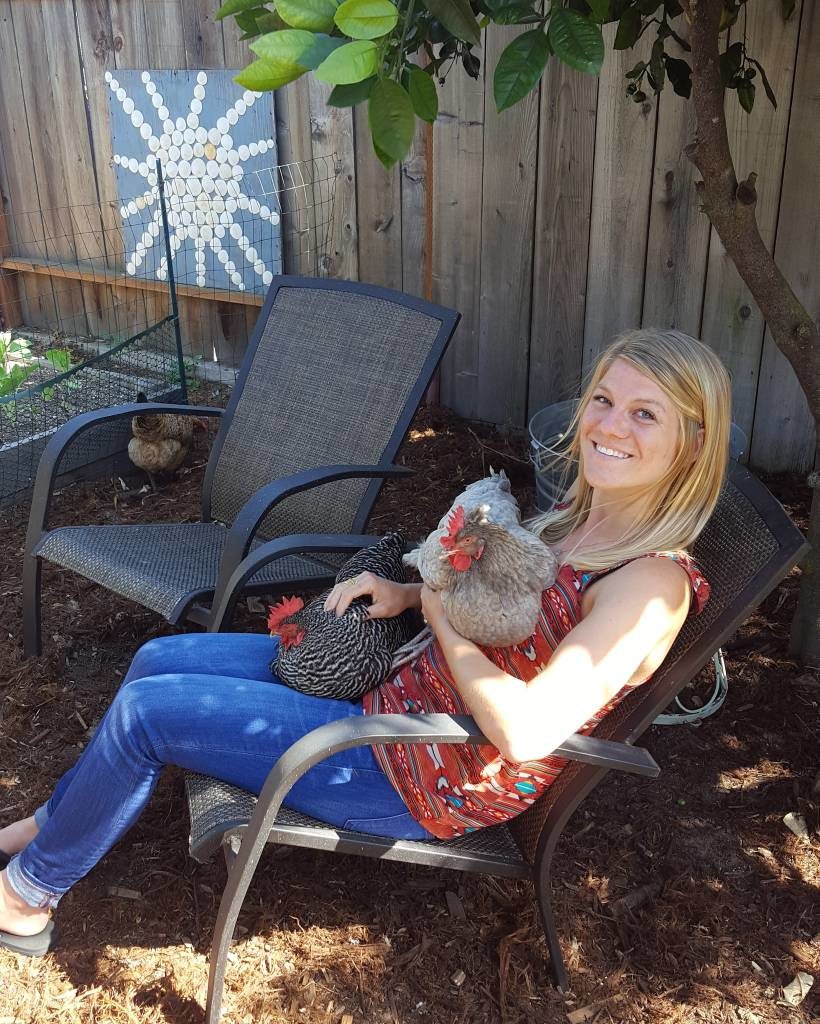
12) Vacations or Late Evenings
Do you have a plan for evenings when you’re out after dark, or when you’re away on vacation? If not, make one! Backyard chickens need to be safely “cooped up” at dark, before any nighttime predators come out. Thankfully, 99% of chickens will simply put themselves to bed, heading into their coop on their own around dusk as their ability to see well rapidly decreases in the dark. Then you can follow behind them and close everything up. Some spunky chickens may try to roost in trees or other naughty places and need re-direction. Yet I don’t think that is very common.
So, what happens if you’re out late after dark? Or worse, away for an extended period of time on vacation? If your chickens are inside a predator-proof run, then may it isn’t a big deal. Otherwise, I highly recommend investing in an automated chicken coop door – explained more below!
An auto door helps A LOT but does not eliminate the need for a family member or a friend to come over to check on the chickens if you’re away on vacation for more than a couple days. They can collect eggs, refresh food and water, possibly deal with poop, and so on. I would suggest every 3 to 4 days, minimum.
Automatic chicken coop doors
Automated chicken coop doors have been a lifesaver for us and our flock, literally. Set them to open in the morning at a certain time, and then close again at night. SO convenient! It’s a good idea to still check on them occasionally to make sure they didn’t malfunction, but we’ve never had that happen. We’ve used a couple different auto doors (solar and battery) and in a couple different configurations over the years – explained in the photo captions below. We currently have the Omlet auto door and absolutely love it!
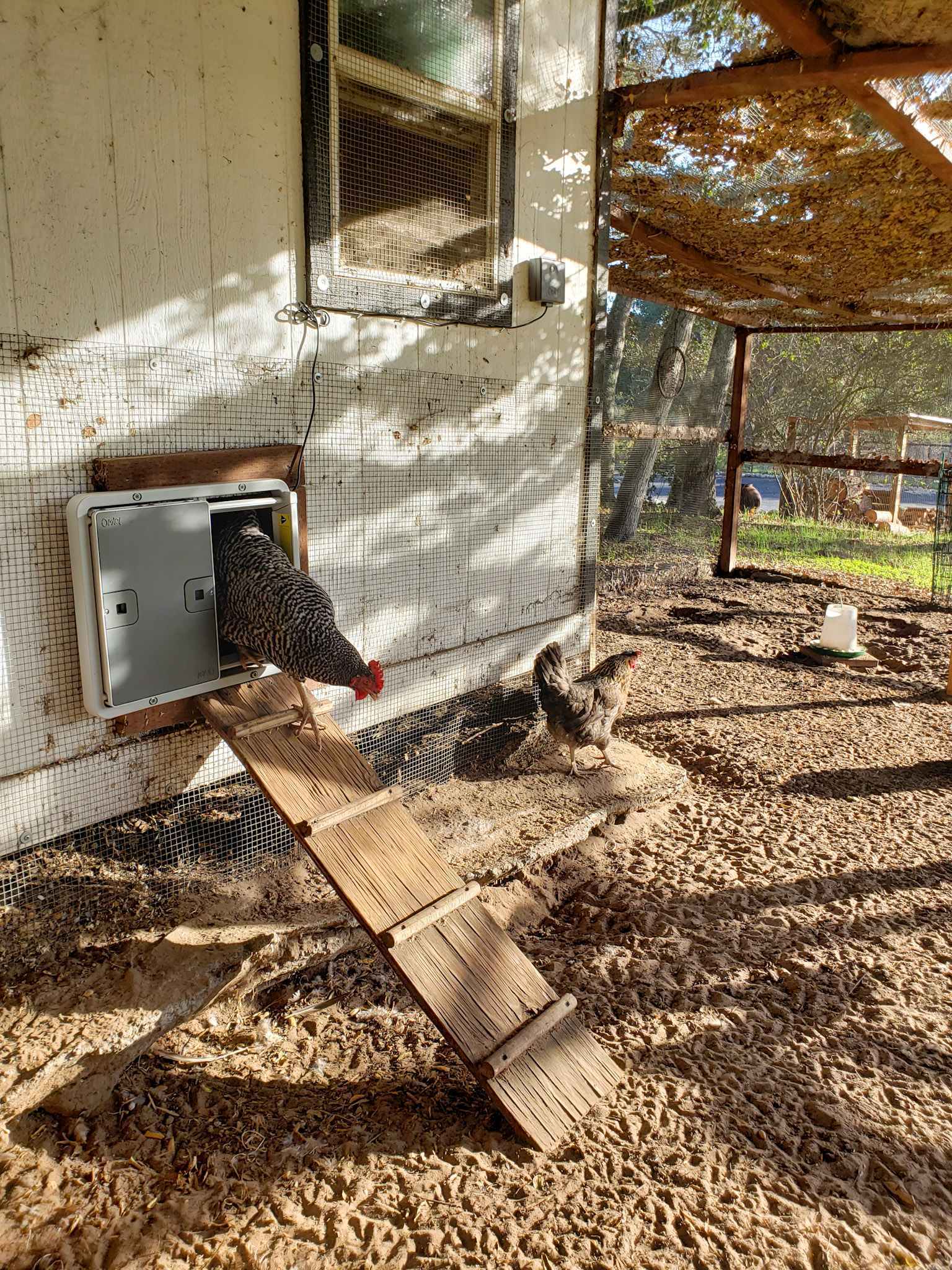
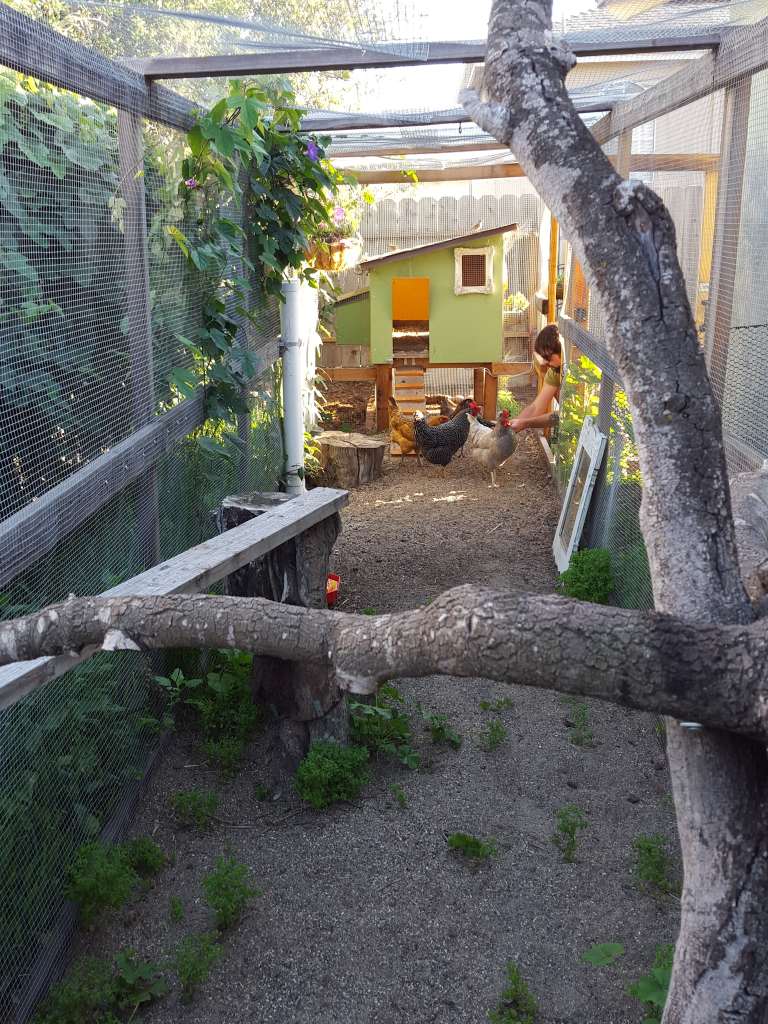
13) Health Issues or Emergencies
There are a number of illness and ailments that can affect backyard chickens, including worms, lice, bumblefoot, crop issues, and issues with egg production – such as egg-binding or internal laying – when eggs are not passing normally and internal infection can ensue.
Many of these issues can be managed with prevention and at-home treatment, but that begs the question: Are you comfortable handling and helping them as needed, such as administering baths or medication? Chances are, even if that sounds weird or scary now, you will be ready to dive in there and help when something goes down! Especially if you raised your chickens from young chicks. You will become accustomed to handling them.
It is recommended to have a large crate, box, spare bathroom, or other readily-available designated space that can serve as an emergency chicken hospital when needed. This space would be used if a girl needs a little TLC, to be quarantined, or an extra watchful eye. It should be large enough for them to comfortably spend a couple days if needed, with food and water available.

For issues that are beyond home-care or your comfort level, do you have a good avian/poultry veterinarian nearby? Or at least a standard vet that will agree to treat chickens? Do a little research ahead of time to know what is available to you. It’s better to know now instead of trying to figure it out during an emergency! Trust me. We have one specialty avian vet as well as our cats vet, who has backyard chickens himself so he will see our birds in a pinch.
14) Looking to the Future
“What will you do with your chickens once they stop laying?” – people ask me this question all the time. The answer is always the same: “They get to live out their lives here, fat and happy, eggs or no eggs”. Chickens can live up to 10 years or longer (though I think the average is more like 6-8), but their egg production will decrease with time. Older hens may only lay one egg a week. Some not at all. Would that be okay with you?
Chances are, between random illness or freak accidents, you likely won’t have all of your original backyard chickens up until old age and the time they’d stop laying entirely. You may lose a couple older gals with time, but then choose to add new younger chicks to your flock, thus giving you another boost of regular eggs. If you do choose to get rid of your older hens for whatever reason, please do so responsibly! Look for no-kill shelters that will take chickens in, or locate a truly trustworthy, good place to re-home them. The same goes for roosters.
I hope you aren’t getting backyard chickens JUST for the eggs, and will consider them your quirky companions as well! We don’t eat meat in this house, but even if we did, we wouldn’t eat our pets. I know many, many people who do eat meat, but would never dream of eating their own chickens. Whether you intend to or not, you will form an attachment! They’re too freakin’ cute and have too much personality not to! Like these cute fluffy broads.

Ginger, a bodacious Welsummer demonstrating a perfect “chicken loaf”, and Phoebe, a Crested Cream Legbar who lays beautiful blue eggs.
Well, there you have it!
Your crash course on backyard chickens is complete.
If you’re still here, thanks for reading! Your future backyard chickens thank you too. I know that was a lot of information to digest, and you probably still have a lot of questions. But I hope you now feel far more prepared to add backyard chickens to your homestead! Feel free to ask questions in the comments, and please share this post if you found it helpful.
You may also like:
- The Top 18 Chicken Breeds for Your Backyard Flock
- Baby Chick Care 101: Brooders, Heat, Health & More
- Feeding Chickens Eggshells or Oyster Shells for Essential Calcium & Health
- 10 Tips on Caring for Chickens in Cold Winter Weather
- 10 Ways to Keep Chickens Cool During Hot Summer Weather or Heat Waves
- When Do Chickens Start Laying Eggs? 5 Tell-Tale Signs It’s Soon!








42 Comments
Kayla
I just came across your blog and I am OBSESSED! You are total homestead goals!! Thank you for all the info!! I cannot wait to get my chickens this year for the first time, and get my spring/ summer garden up and running again after a long harsh winter here in Buffalo, NY! Thank you again!!
Aaron (Mr. DeannaCat)
Hi Kayla, glad to hear you found us! It’s also great to hear you are ready to hit the ground running in your garden once the temperature starts to warm up and getting your first chickens is really a fun and special time. Have fun and we hope to see you around.
Michelle
Hi! Love your blog, it’s been really helpful with so many things! We have an auto door on the run into a fenced area for our ladies however we have issues with ground squirrels (summer) and birds (winter) going in the coop for the food any thoughts on how to deter them from entering but not the hens? I was thinking fabric strips. And I do have additional food in the fenced area so the feeder in the coop isn’t the only food source. Also, Wanted to confirm that’s the 15 gallon metal bin for the dust baths.
Thanks!
Ps. Also recently purchased an irrigation kit for raised beds through your link to Drip Depot so hopefully you got the commission!
Aaron (Mr. DeannaCat)
Hi Michelle, keeping out squirrels and other birds can be a problem, we never had squirrel issues here but we would get a few song birds that would go in and out of the run to eat some feed but it was never too much of an issue, but they would never venture into the coop itself as we only never had feed in the coop. Hanging fabric strips can be an option if your chickens don’t seem to mind them, you may have to watch how your chickens respond to the strips as their response could go either way. Do your chickens spend a lot of time in the coop during the winter and is keeping the feed in their coop necessary? Sorry couldn’t be of more help but it may take a little experimentation on your part to figure out what works best, we appreciate your support and hope the irrigation system makes your life easier in the garden while growing great plants!
Michelle
Thanks for the feedback! I actually meant the run not the coop, we’re in California near Sacramento so they don’t spend a lot of time in there. Glad to hear you don’t have a ground squirrel problem, they are worse than the gophers on the tunnel digging!
Aaron (Mr. DeannaCat)
Sounds good Michelle, I am from Chico and that is where Deanna and I met, very familiar with squirrels although they were mostly the gray tree squirrels that were an issue.
Mary
I wanted to Thank You! I have been considering raising chickens for decades! Finally, that may happen. I learned so much and am eager to learn more about them! (As well as an inexpensive option for housing them.) There isn’t much spare money. Thanks again!
Laurissa
I wanted to make a dust bath for my chickens, they ususally roll around in my garden bedsbut i have plants in them current and fence them off to the chickens. What should I use for the “dust”? I also think they have bugs, maybe mites.
Aaron (Mr. DeannaCat)
Hi Laurissa, some things you can do to help prevent mites from getting to your chickens is offering a place to dust bath, apply food grade diatomaceous earth to their coop and bedding (be sure to not inhale the cloudy fine particles), add garlic or ACV to their water, and keep their coop clean. If you think they have mites I would clean out their coop entirely, add new bedding with DE spread throughout, and add a dust bath to their run area (we have just used native soil for dust bathing). To actively treat chickens that have mites, people often dust them with wood ash mixed with DE, check out this article on how to go about doing that. Hope that helps and good luck!
Dejah
Deanna, I can’t thank you enough for your chicken articles and all of the fantastic information inside. I DO have a question that I couldn’t find addressed in your article – BROODY HENS. I’ve seen lots of good information about “breaking the brood,” even, “broody jail,” but I’d love to know how you address this issue. We’re dealing with our first broody silkie (no surprises there) and I’d have to say, she now sounds like something between jurassic park and demon possession! LOL. Anyhow, what are your best practices on this? Thanks so much! Cheers!
Aaron (Mr. DeannaCat)
Hi Dejah, unfortunately enough (or fortunately in our case) we haven’t had to deal with a broody hen. It is best to lower their body temperature and keep them away from their nesting area. If you have a crate with a slotted bottom, that can take the place of their nesting area and will allow airflow through the slats. Some people even dunk the broody hen in water to lower her body temperature. Backyardchickens.com is a good forum for chicken information. Hope that helps and good luck to breaking your broody hen.
Kerry
How did you tackle that butt feather eating situation? I’m trying to break the habit with my ladies (we’ll just one lady) right now. She’s driving me nuts!
Aaron (Mr. DeannaCat)
Hello Kerry, you could separate the one chicken with fencing so they can still see one another and it will still slightly resets the pecking order. Making sure your chickens have plenty of space and things to keep them active and busy can also help with the feather eating situation. It seems they can get in habits with things but once they are broken of it, they seem to forget all about it. I know it can be frustrating but stay vigilant and the behavior should stop in time. Hope that helps and good luck!
Leah
Hi Deanna! Did you ever post or share more about your coop and run design/plans/building process? I just stumbled on your blog and love your content and chicken set up, just wondering if there is another post with more details as I haven’t found it. Thanks!
Aaron (Mr. DeannaCat)
Hello Leah, we haven’t done a post on our coop design as of yet though it may be something that we tackle down the line.
LISA
Hello from Australia, I like reading your page as love gardening too, but my garden is big and tropical, today I just planted a tree for the Ulysses butterfly. This year intend to go organic, no dreadful poisons just some neem oil, yes have your recipe, plan to grow aloe vera as only have a aloe hybrid not sure if it will work. Also experimenting with growing other herbs for medicinal uses. Thanks love your garden xx
Erin Seelert
Hey Deanna!! I can’t begin to tell you how helpful this article was for me before I got my first flock (which was a short 2 mos ago lol). Raising chickens is the absolute best!
Dessaray Greminger
Hi Deanna!!
I’m so happy to have found your blog!! Really good stuff here 🙂
I too live in Santa Barbara and am on the hunt for baby chicks that come from a humane farm or breeder ☺️ Emphasis on the HUMANE.
I’m soooo excited to raise healthy friendly chicks and reap the benefits of farm fresh eggs, but only if I can support a farm that treats chickens right!
So my question is, do you know of a nearby farm to breeder I can drive to instead of shipping the little babies? One that doesn’t dispose of the male chicks, allows their chickens to be free range and has a wide enough variety of breeds?
I’ve done so much research and called around but it’s hard to tell who’s legit… i called My Pet Chicken and they say they’re good to the chicks… but it looks like such a large hatchery online and they don’t have photos or allow visits so again.. hard to tell.
Anyway, I know you have similar morals here and just thought I’d ask since you’ve probably done the research as well!!
Really hope to hear back from you soon :))
Beat,
Dessaray
DeannaCat
Dessaray – hey neighbor! I am not 100% sure on their practices with male chicks, but you could look in to Dare to Dream Farms in Lompoc. They’re one of the only local chicken farms I know of in the area. I suggest getting day-olds (or as close to is as possible) over older chicks if you’re hoping for friendly birds. In my experience, they bond with their humans and become more docile that way. Another option to consider is hatching your own eggs at home. That is a big step (something we haven’t yet done) but a really cool process, and then you know you’re getting 100% humanely treated chicks from the start, including the males. For that, I suggest ordering fertile hatching eggs from Alchemist Farms in Sebastopol. They’re good people and have a great selection of beautiful breeds. Best of luck! Deanna
Jennifer
Hi Deanna!
First, your articles and content are fantastic! Thank you!
My family and I just started with our very first flock of chickens. We got 6 altogether and are really enjoying the journey. We just transitioned them outside. I started using a paint scraper per your suggestion to clean the coop daily. I was planning on doing the deep litter method in the winter since it can be harsher in Pennsylvania. My question is, if I am scraping/cleaning daily in the warmer months is there a need for me to still have bedding on the coop floor?
Also, do you have any favorite books/accounts to following for all things chicken that one may need to know? I trust your expertise! Thanks in advance!
Aaron (Mr. DeannaCat)
Hi Jennifer, thank you for the kind words and support. We still like to use shavings inside their coop as the chickens still spend a bit of time going in and our of their coop and they will inevitably poop throughout the coop as well. We also like to dust the floor of the coop with DE after a thorough clean out and the shavings help keep the DE more suppressed in the litter. We also have other chicken related articles that may be helpful if you haven’t read those yet.
As far as different chicken books or accounts, we have found BackYard Chickens and especially their forum to be extremely helpful when it comes to diagnosing chicken problems or health issues that may arise in your flock. We also like this book on everything chickens, hope that helps and good luck with your new flock!